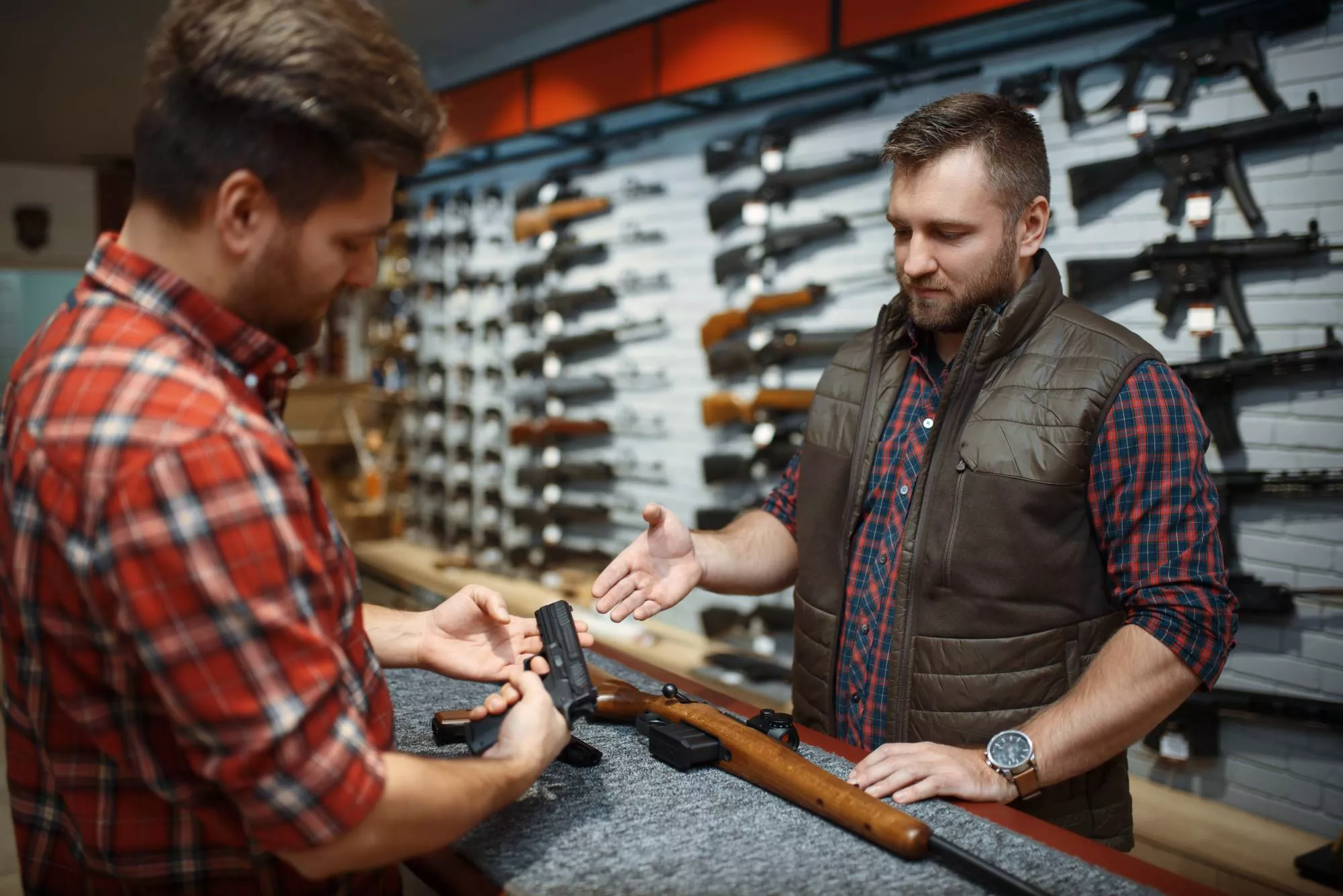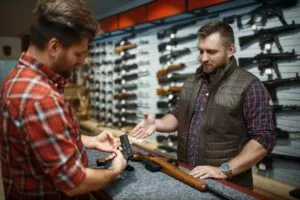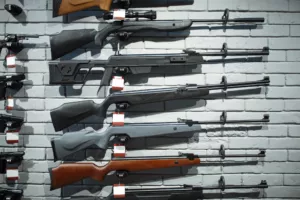
TABLE OF CONTENTS
- What Is an FFL Transfer?
- FFL Transfer Process: How Does an FFL Gun Transfer Work?
- FFL Transfer Rules
- How an FFL Transfer Takes Place Online
- The Cost: What Is the FFL Transfer Fee?
- How to Find an FFL for a Transfer
- Common Misconceptions About FFL Transfers
- How to Transfer an FFL: Closing Thoughts
- FFL Transfer FAQs
- Reviewed by Ryan Cleckner
If you’re in the process of starting a firearms business, you may have come across the term “FFL transfer.” Below, we explain exactly what an FFL transfer is, as well as each step of the transfer process, associated fees, and other pertinent information regarding transfers. With U.S. gun sales surging among first-time gun owners, possessing such insight into FFL transfers is an invaluable asset for any firearms business owner. Read on to find out how FFL transfers affect your business, online and offline, and at the federal, state, and local levels.
What Is an FFL Transfer?

“FFL” is an acronym for Federal Firearms License. In the US, you must obtain a Federal Firearms License to legally sell, import, or manufacture firearms within your business operations. However, the term “FFL” also commonly refers to a holder of a Federal Firearms License. In the latter case, “FFL” is an acronym for Federal Firearms Licensee. Often used interchangeably, “FFL” refers to either the license itself or the holder of the license.
Meanwhile, a Federal Firearms License transfer requires a licensee to turn over the possession of a firearm to another licensee before it may then go to a customer or non-licensee. Therefore, the term “FFL transfer” specifically refers to a firearms sale through a licensed dealer.
So, how did this originate?
The Gun Control Act of 1968 requires an FFL to transfer firearms sold, gifted or loaned across state lines. However, an in-state sale, gift, or loan of a firearm does not always require an FFL transfer, as this depends on the state’s individual laws. To confirm whether or not your state requires FFL transfers within its boundaries, please refer to your state’s gun laws.
Additionally, the National Firearms Act (NFA) set regulations for specified items, such as silencers or short-barreled rifles. As per the NFA, you may only transfer such items to an FFL, who is also an SOT. Yet another acronym, “SOT” stands for Special Occupation Taxpayer license. SOT licensees may transfer, sell, import, and manufacture NFA items. The Internal Revenue Code of 1986 granted SOT licensees certain tax benefits as well.
What is an FFL dealer?
To initiate a transfer, a customer must contact an FFL dealer. An “FFL dealer” may be classified as a gun shop owner or gun dealer who holds a Federal Firearms License. Therefore, an FFL-to-FFL transfer entails the shipping of guns between two gun stores and/or dealers, each of whom possesses a Federal Firearms License.
What is an NFA transfer?
An NFA transfer is the high-level process of transferring an NFA item from one person to another. The Bureau of Alcohol, Tobacco, Firearms, and Explosives (ATF) requires licensed dealers to manage any and all transfers of NFA items. Additionally, the ATF must review and approve each NFA transfer.
FFL Transfer Process: How Does an FFL Gun Transfer Work?
When an individual buys a gun from an FFL dealer, federal gun laws require said dealer to run a background check on the buyer. The process of an FFL transfer is dependent on this background check, as prospective buyers who do not pass will not be eligible to proceed with the transfer. That said, the five steps listed below comprise the process of an FFL transfer.
Step 1: Review gun’s eligibility
First, the FFL holder verifies that the gun is legally eligible for transfer to the buyer.
Step 2: Initiate the transfer with an ATF form
The buyer fills out an ATF Form 4473. This form asks for basic information about the buyer, including their name, address, and date of birth.
Step 3: Background check
Next, the FFL dealer from whom the buyer is purchasing runs a background check on the buyer through either the National Instant Criminal Background Check System (NICS) or their state’s background check system.
Step 4: Review the background check results
If the background check comes back with a “clear” result, the FFL dealer moves on to Step 5. However, if the background check comes back with a “delay” or “proceed” result, the FFL dealer must wait three days, at which point the NICS delivers its final decision. If NICS does not render a decision within three days, the FFL dealer may move on to Step 5.
Step 5: Pay for the Gun and Complete the Transfer
After completing any paperwork necessary to finalize the transaction, the buyer pays for the gun. At this point, the FFL holder transfers the gun to the buyer. The FFL transfer is complete!
FFL Transfer Rules
Due to the regulations of the firearms industry, it’s important to be familiar with all FFL transfer rules when conducting a trade.
Upon receiving a “proceed” response from a background check of a prospective buyer, an FFL should record the firearm into their acquisition and disposition (A&D) log, noting that the gun, in this case, is a firearm from a private seller. The serial number of the firearm will also be recorded in their A&D log. Then, after completing Section D of ATF Form 4473, the licensee may transfer the firearm to the private buyer. Finally, the licensee must record the transfer disposition in their A&D log within seven days after the transaction.
Note: An acquisition and disposition (A&D) log is also commonly referred to as an ATF bound book.
What happens if the NICS background check returns a “denied” or “canceled” response?
If the FFL receives a response of “denied” or “canceled,” after performing a background check, the transfer is void. If the private seller has not given the FFL exclusive possession of the firearm, he or she can leave the business premises with the weapon. The gun will not be recorded as an acquisition in their A&D log. However, if the background check comes back as “denied” or “canceled,” and the private seller has given exclusive possession of the firearm to the licensee, the FFL must record the gun as an acquisition from a private seller in their A&D log.
If the FFL receives a response of “proceed” or “delayed” and the NICS issue its final decision within three business days, the FFL can either continue the transfer or terminate the transaction. In the event of the FFL continuing the transfer, the private seller does not need to return to the gun shop to complete the transaction. The FFL may complete the transfer to the buyer and record the disposition to the buyer in the A&D log within seven days.
Need support for your firearms business?
We help businesses that are normally turned away
Merchant Account today!
Approval
Rate
How an FFL Transfer Takes Place Online
No matter the industry into which your business falls, providing your customers with a secure eCommerce experience is of the utmost importance. In the case of the firearms industry, this is doubly true. Selling firearms online—and even in person, for that matter—is considered high risk. That said, you must be on top of industry standards.
If a buyer purchases a gun online, they must contact a local FFL-holding dealer to facilitate the transaction. In this case, the eCommerce retailer ships the gun to the licensed dealer, not directly to the buyer’s residence. When the online buyer picks up the gun, the following steps take place:
- The licensed dealer records the weapon’s serial number in their A&D log.
- The buyer provides their government-issued photo I.D. and fills out ATF Form 4830. This way, demographic data can be collected to ensure that the buyer is not prohibited from buying a firearm.
- The FFL runs a background check on the buyer through the NICS database.
- After the buyer passes the background check, an FFL transfer is made from the licensee to the buyer.
- The buyer pays the associated fee for the firearm transfer. Now, the transaction is complete.
The Cost: What Is the FFL Transfer Fee?
A major element of a firearm transfer is the FFL transfer fee. In fact, many firearms business owners can make a small profit from FFL transfer fees alone.
The licensee charges an FFL transfer fee of $20 to $50 for processing the necessary documentation. This includes the price for conducting the NICS background check. However, $20 to $50 is simply the average FFL transfer fee, which may vary. More reputable licensees can change higher FFL transfer fees.
How to Find an FFL for a Transfer
A Federal Firearms Licensee (FFL) is an individual or business licensed by the federal government to legally sell firearms. In order to find an FFL near you, there are a few resources you can use:

- ATF Website: The ATF maintains the most comprehensive database of FFLs. To find an FFL near you, you can search the ATF database by zip code.
- Armslist: Another option is to search for FFLs on Armslist.com. Armslist is a comprehensive online gun marketplace. (Think of Craigslist, but specifically for firearms.) The listing should indicate if the seller is an FFL. Many sellers will also offer to ship the weapon directly to an FFL near you to start the transfer process.
Once you find a dealer you’d like to use, contact them to verify they possess an active FFL license. When transferring a gun, it is important to use an FFL to ensure the transfer is conducted legally and safely.
Common Misconceptions About FFL Transfers
One of the most common misconceptions about FFL transfers is that they are a form of gun registration. This is simply the process of transferring a firearm from one Federal Firearms Licensee to another Federal Firearms Licensee. The only information that is typically exchanged during a transfer is the make, model, and serial number of the firearm, as well as the name and address of the transferee.
Another common misconception is that transfers are only for businesses. However, private individuals can request an FFL transfer if they are buying a gun from an out-of-state dealer or selling a gun to an out-of-state buyer. In both cases, the transfer must be conducted through a licensed firearms dealer.
Finally, some people incorrectly believe that an FFL transfer is required to ship a gun across state lines. However, this is not always the case. It depends on the state and the weapon. Refer to state regulations to ensure you comply with all necessary laws.
How to Transfer an FFL: Closing Thoughts
The FFL transfer process is designed to ensure that firearms move safely and legally from one owner to another owner. With careful planning and attention to detail, any licensee can smoothly facilitate a transfer process without incident. However, as the owner of a firearms business, you may find that complying with federal, state, and local regulations regarding the selling of firearms is not the most difficult challenge in managing a firearms business, but rather that it’s securing a payment processing partner. Because the firearms industry is considered high risk, many financial institutions keep their distance. By partnering with a gun-friendly payment processor, you’ll be able to accept payments for firearms sales, as well as collect FFL transfer fees. And, as stated earlier, FFL transfer fees may end up accounting for a substantial portion of your business’s revenue. Start processing payments and transferring firearms today!
FFL Transfer FAQs
When do firearms transfers take place?
The transfer of a firearm takes place when an FFL sells a gun to a customer or when an FFL turns over a gun to another FFL for customer pick-up.
Typically, those wishing to sell a gun across state lines need an FFL dealer to facilitate the transaction, with the gun being sent to an in-state licensed dealer and the buyer picking up the firearm from them. Likewise, if a customer would like to buy a gun from you online, you must send the gun to an FFL dealer in their state from whom the customer may receive the firearm.
A complete breakdown of the FFL transfer process is outlined above.
How do interstate FFL transfers work?
Not every gun transfer requires facilitation by an FFL. The exact rules depend on your state. Federally, out-of-state sales of firearms require an FFL to facilitate the transfer. Additionally, some states require an FFL transfer for every gun purchase. And if you make a gun sale online, it’s safe to assume you probably need an FFL transfer.
Here’s a matrix to illustrate this point:
| Weapon Ownership | In-State | Out-of-State |
| Firearm owned by an individual | FFL transfer not federally required, but may be required by the state | FFL transfer required |
| Firearm owned by an FFL | FFL transfer required | FFL transfer required |
Once you find an in-state FFL, confirm that they are willing to receive transfer firearms from out-of-state dealers.
How long does an FFL transfer take?
The length of time it takes to complete an FFL transfer varies depending on a number of factors. From the moment your customer submits the ATF Form 4473 to the point at which they are the legal owner of the weapon can take anywhere from a few days to a couple of weeks. Factors that may delay this transaction include:
- The Background Check: The background check may take a few days, depending on whether any prior charges or convictions are found.
- The Weapon: If the weapon is ineligible for transfer or needs to remove modifications to be legal in the state of ownership, the transfer will be delayed until the required changes are complete.
- Shipping: In the event that the gun must be shipped, the shipping process can take a few days.
- Inspection: Once the gun arrives, the dealer conducts a final inspection before releasing the gun to the customer. This inspection may be a source of delay if the dealer is busy/conducting many transfers.
What if an FFL transfer applicant fails the background check?
If the buyer fails the background check, the dealer is unable to complete the transfer. In this case, the buyer may appeal the decision or request a hearing with the ATF.
Should your business offer FFL transfers?
If you own a firearms business, you must obtain a Federal Firearms License to transact transfers. While you do not need to obtain an FFL if you only sell ammunition, you do need to obtain one if you intend to sell firearms. Therefore, an FFL must be obtained if you:
- Commercially sell guns or engage in the buying and/or selling of guns
- Manufacture ammunition (as noted, you don’t need an FFL if you only sell ammunition)
- Import or export firearms or ammunition
- Manufacture firearms, firearm receivers, or frames
If you intend to sell firearms for a profit, you need to obtain an FFL to do so legally. And because obtaining an FFL enables you to facilitate transfers, this is a service you may legally offer as a licensee.
This article has been reviewed by Ryan Cleckner and is factually accurate as of July 25, 2022.
Reviewed by Ryan Cleckner
Ryan Cleckner, the best-selling author of the Long Range Shooting Handbook and founder of Gun University and Rocket FFL, is a recognized firearms attorney specializing in firearms law/ATF compliance. Ryan has made appearances on the History channel as a sniper expert, and Fox as an industry expert.






